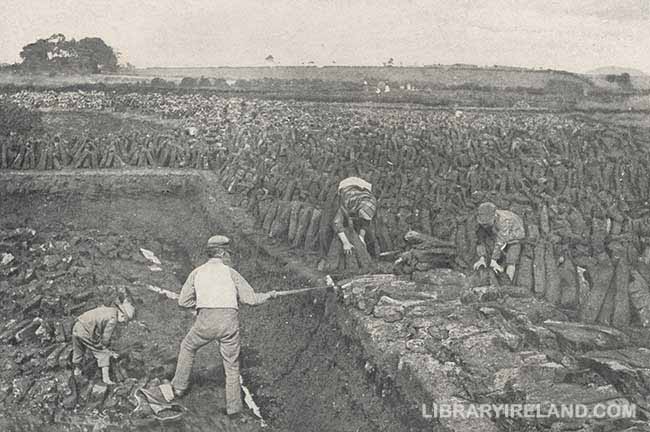Fallcarragh to Gweedore
WE are now on the road to Fallcarragh, seven miles distant, and we pass his Majesty's mail, northbound from Letterkenny, a crimson car loaded with mail-bags and luggage, and a driver wearing a bright-yellow sou'wester. Everything was drenched and the horse in a steaming lather—truly a novel sight for a denizen of Broadway.

A Turf Bog
Fallcarragh is the place from which you take a boat to visit Tory Island, some eight miles out in the Atlantic. It has been called "the Sentinel of the Atlantic," and it is well named, being the first land one sees when nearing Ireland. Its name means "the island of towers," and it looked from the deck of the Columbia as though it had been built up by some titanic race of old. It did not seem to us that it could be of much value, but it was considered important enough to fight for in the early days "when giants were in the land." The Book of Ballymote states that it was possessed by the Fomorians, a race of pirates and giants who inhabited Ireland twelve centuries before the Christian era. Their chief was "Balor of the Mighty Blows," and two of the rocks on the east coast of the island are called "Balor's Castle" and "Balor's Prison." One of their number, named Conaing, erected a tower on the island, as recorded in the Book of Lecan:
"The Tower of the Island, the Island of the Tower, The citadel of Conaing, the son of Foebar."
It contains a portion of a round tower, built of undressed boulders of red granite. It was never more than about forty feet in height, is seventeen feet two inches in diameter, and the walls at the base are four feet three inches thick; the doorway is five and a half feet high and is eight feet from the ground. There are also ruins of two churches (a monastery having been founded here by St. Columba), and a peculiar tau-cross. On the northwest end of the island is a fine light-house, illumined by gas, and it has also a fog-siren and a group-flashing light; it stands a hundred and thirty feet above high-water. Near it is the new signal station of Lloyd's, which is in telegraphic communication with Dunfanaghy. There are a chapel, school-house, and post-office also on the island. The rock scenery of the northeast coast is very fine and characteristic; the southwest coast is low and flat, and fringed with treacherous rocks. It was here that the gunboat Wasp was wrecked on the 22d of September, 1884, and all its crew except six drowned. Fishing is the chief industry, and the islanders are good fishermen, pursuing their avocation now chiefly in Norway yawls instead of "curraghs." The Congested Districts Board have aided the inhabitants by supplying these vessels, the cost to be repaid by small instalments, also in building a curing station and teaching the people how to cure fish. Quantities of lobsters and crabs are caught, and a Sligo steamer calls once a week for fish. There is a lack of fuel, which has to be supplied from the main-land. The inhabitants have paid no rents since the loss of the Wasp, which was sent to enforce payment or evict the tenants. St. Columba, the patron saint of the place, is reported to have landed here in a curragh.
From Fallcarragh you get a fine view of Muckish, with its twenty-two hundred feet of altitude. While not the highest mountain in the Donegal highlands, Muckish is longer and of greater bulk than any of its rivals, and is also more imposing. Its name in Irish means "a pig's back," which it very much resembles. Here is Ballyconnell House, seat of Wybrants Olphert, Esq., where the "Plan of Campaign" was originated, so well known in connection with the landlord and tenant troubles in Ireland.
We now took the shore-road through a district known as Cloughaneely, where English is rarely spoken and we had to make our way by signs, spending a few minutes en route at a national school and hearing them teach the children both Irish and English. Continuing, we passed close to Bloody Foreland, a head one thousand and fifty feet high, so called because of its ruddy color. Arriving at Bunbeg, we stopped to feed the horse and take some lunch ourselves, and then "made play" for the Gweedore Hotel. Our road took us past the spot where Inspector Martin was clubbed to death when executing a warrant for the arrest of the Rev. James McFadden, P. P., in February, 1889, in connection with the Gweedore evictions.
Read "On an Irish Jaunting Car through Donegal and Connemara" at your leisure
Read On an Irish jaunting Car through Donegal and Connemara at your leisure and help support this free Irish library.
Samuel Gamble Bayne was born in Ramelton, County Donegal, and educated at Queen's University in Belfast. At the age of twenty-five he left for America with a view to making his fortune. He invested in an oil well in Pennsylvania and later founded a bank which subsequently came to be the JP Morgan Chase bank in New York. By the time this book was written he was wealthy enough to be referred to as a billionaire. His account of the tour through the north, west and south of Ireland is a pleasant snapshot of how that part of the country was in the early part of the 20th century. He describes what is to be seen, gives some background history and, through the illustrations especially, provides wonderful glimpses of the area's social history.
The ebook is available in .mobi, .epub, and .pdf formats. See details ».

